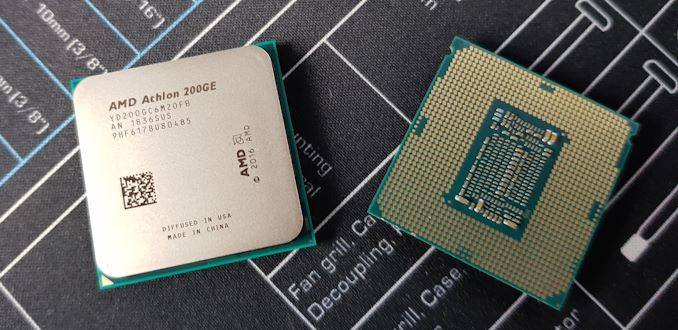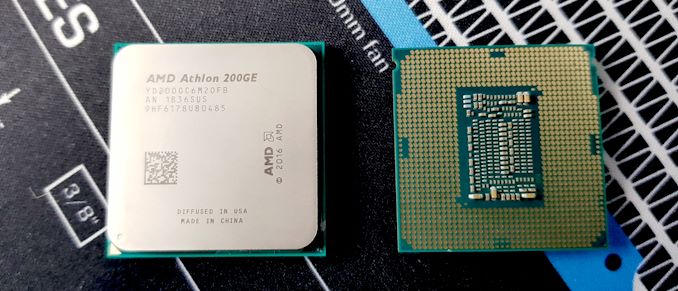The $60 CPU Question: AMD Athlon 200GE or Intel Pentium Gold G5400? A Review
by Ian Cutress on January 14, 2019 8:00 AM EST
In the course of our reviews, when we get a chance to get hands on with random processors, we run our test suite and add the data to our database. Sometimes that doesn’t materialize directly into a review, but at least we have the data. Two very similar CPUs have come across my desk recently: AMD’s dual core Athlon 200GE, and Intel’s Pentium G5400. Both chips round to the $60 mark, have some form of integrated graphics, and are aimed at budget systems.
This is going to be fun
One of the perennial issues with modern technology review cycles is that there’s a lot of focus on the high-end parts. These are the ones that the manufacturers sample: they have the highest margins, but are also the halo products: if they sit atop of the standings, then the hope is that that influence will trickle down into the rest of the product range, typically the high-volume parts. There is also the added benefit that more people want to hear about the best of the best. It’s a reason why there are so many Ferrari and Aston Martin ‘WOW’ pieces in written and video media.
Normally this would make sampling very difficult. If we were reviewing cars, anyway. The two chips in today’s analysis, the Intel Pentium Gold G5400 and the AMD Athlon 200GE, cost around $60 apiece, which I forked out for personally as I was never expecting to be sampled. (AMD asked if I wanted a 200GE sample two days after my retail unit arrived, go figure. I sent that on to Gavin for his 7-year old’s new gaming system.)
| AMD vs Intel at ~$60 | ||
| AMD Athlon 200GE |
Intel Pentium Gold G5400 |
|
| Cores / Threads | 2 / 4 | 2 / 4 |
| Microarchitecture | Zen | Coffee Lake |
| Motherboards | X470, X370, B450 B350, A320, A300 |
Z390, Z370, Q370 H370, B360, H310 |
| CPU Frequency | 3.2 GHz | 3.7 GHz |
| L2 Cache | 512 KB/core | 256 KB/core |
| L3 Cache | 2 MB / core | 2 MB / core |
| Integrated Graphics | Vega 3 192 SPs |
UHD 610 12 EUs (96 ALUs) |
| DDR4 Support | DDR4-2933 | DDR4-2666 |
| GPU Frequency | Up to 1000 MHz | 350-1050 MHz |
| TDP | 35 W | 54 W (2-core die version) 58 W (4-core die version)* |
| Price | $55 (SRP) | $64 (1k/u) |
| * Intel harvests both 2+2 and 4+2 dies to make G5400 parts. It's impossible to know which one you have without removing the lid and measuring the die area. | ||
When we stack up the two processors side by side, it gets interesting. Both are dual core, quad thread parts. The Intel processor has the frequency advantage, running at 3.7 GHz compared to the 3.2 GHz of AMD, but the AMD has beefier Vega 3 integrated graphics compared to the UHD 610 (GT1) graphics of the Intel chip. One sore point might be the TDP, where the AMD chip has a rating of 35W and the Intel chip is rated at 58W, however as we’ll see in the review, neither of them come close to those values.
Tackling the budget end of the market is fun. I’ve been a long-time advocate for budget builders to build a system piece-by-piece, getting one high-end part at a time rather than smearing a budget across several average parts at once. Under this philosophy, these processors could very well be the start of one of those builds, only costing an average of $60 MSRP. Note that under this philosophy, you might end up with that big graphics card before a processor that can power it. We’re covering those benchmarks as well.
Before you click further, place your bets on who you think will win: the Intel Pentium Gold G5400, or the AMD Athlon 200GE?
Latest News: While neither processor is officially overclockable, since we tested for this article it was recently reported that MSI motherboards with certain BIOS versions will allow users to overclock the 200GE to ~3.9 GHz. I've asked Gavin to contribute, and he managed a nice 3.9 GHz over the 3.2 GHz base clock. Head over to page 21 for the details.
Pages In This Review
- Analysis and Competition
- Test Bed and Setup
- 2018 and 2019 Benchmark Suite
- CPU Performance: System Tests
- CPU Performance: Rendering Tests
- CPU Performance: Office Tests
- CPU Performance: Encoding Tests
- CPU Performance: Legacy Tests
- Gaming: Integrated Graphics
- Gaming: World of Tanks enCore
- Gaming: Final Fantasy XV
- Gaming: Shadow of War
- Gaming: Civilization 6
- Gaming: Ashes Classic
- Gaming: Strange Brigade
- Gaming: Grand Theft Auto V
- Gaming: Far Cry 5
- Gaming: Shadow of the Tomb Raider
- Gaming: F1 2018
- Power Consumption
- Overclocking
- Conclusions and Final Words











95 Comments
View All Comments
kkilobyte - Monday, January 14, 2019 - link
s/i3/Pentium. Obviously :)freedom4556 - Monday, January 14, 2019 - link
I think you messed up your charts for Civ 6's IGP testing. That or why are you testing the IGP at 1080p Ultra when all the other IGP tests are at 720p Low?freedom4556 - Monday, January 14, 2019 - link
Also, the 8k and 16k tests are pointless wastes of time. Especially in this review, but also in the others. Your low/med/high/ultra should be 720p/1080p/1440p/4k if you want to actually represent the displays people are purchasing.nevcairiel - Monday, January 14, 2019 - link
The Civ6 tests are like that because thats when it really starts to scale like the other games. Look at its IGP vs Low, which is 1080p vs 4K. The values are almost identical (and still pretty solid). Only if you move to 8K and then 16K you see the usual performance degredation you would see with other games.AnnoyedGrunt - Tuesday, January 15, 2019 - link
I second this motion. Please have settings to cover the various common monitor choices. 1080P is an obvious choice, but 1440P should be there too, along with 4K. I don't think you need to run two 4K versions, or two 1080P versions, or whatever. I have a 1440P monitor so it would be nice to see where I become GPU limited as opposed to CPU limited. Maybe Civ6 could use some extra high resolutions in the name of science, but to be useful, you should at least include the 1440P on all games.Thanks.
-AG
eddieobscurant - Monday, January 14, 2019 - link
Another pro intel article from Ian, who hopes that someday intel will hire himPeachNCream - Monday, January 14, 2019 - link
The numbers in the chart speak for themselves. You don't have to acknowledge the conclusion text. It's only a recommendation anyway. Even though I'd personally purchase a 200GE if I were in the market, I don't think there is any sort of individual bias coming into play. Where the 200GE is relevant, gaming on the IGP, Ian recommended it. In other cases the G5400 did come out ahead by enough of a margin to make it worth consideration. The only flaw I could tease out of this is the fact that the recommendation is based on MSRP and as others have noted, the G5400 is significantly above MSRP right now. It may have been good to acknowledge that in the intro and conclusion in a stronger manner, but that means the article may not stand up as well to the test of time for someone browsing this content six months later after searching for advice on the relevant CPUs via Google.kkilobyte - Monday, January 14, 2019 - link
Acknowledge "in a stronger manner"? Well, it is actually not acknowledged in the conclusion at all!The title of the article is: "The $60 CPU question". One of those CPU is clearly not being sold at $60 on average, but is priced significantly higher. I think the article should have compared CPUs that are really available at (around) $60.
So maybe there is no personal bias - but there is clearly ignorance of the market state. And that's surprizing, since the G5400 price was above its MSRP for several months already; how could a professional journalist in the field ignore that?
I guess it could be objected that "MSRP always was used in the past as the reference price". Granted - but it made sense while the MSRP was close to the real market price. It doesn't anymore once the gap gets big, which is the case for tbe G5400. Nobody gives a damn about the theorical price if it is applied nowhere on the market.
And the 'numbers of chart' don't 'speak for themselves' - they are basically comparing CPUs whose retail price, depending on where you get them, show a 20-40% price gap. What's the point? Why isn't there a price/performance graph, as there were in past reviews? The graphs could just as well include high-end CPUs, and would be just as useless.
If I want to invest ~$60 in a CPU, I'm not interested to know how a ~$90 one performs!
sonny73n - Tuesday, January 15, 2019 - link
+1I couldn’t have said it better myself.
cheshirster - Wednesday, January 23, 2019 - link
Yes, 5400 is priced nowhere near 60$ and reviewer definitely knows it, but fails to mention this in conclusion.